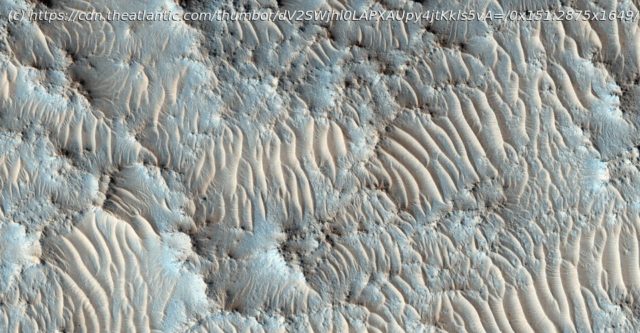The newest Mars rover will avoid the places where life might be thriving right now and search for long-dead microbes instead.
The very first time NASA put a robot on Mars, it was looking for one thing: life.
When scientists examined the mission’s early findings, they sent for champagne. They were convinced they’d discovered proof, quietly metabolizing, in the soil. But the data turned out to be muddled, and one experiment designed to detect organic molecules found none, not even simple ones that astronauts had found on the moon.
Nearly half a century after that mission, its latest successor, a rover called Perseverance, left Earth this morning to scour Mars’s surface for signs of alien microbes.
The thought of the red planet bustling with alien beings has fascinated scientists for centuries. Some imagined a landscape shaped by an intelligent civilization—until telescopes became sophisticated enough to detail the planet’s surface. Others thought they saw dark swaths of vegetation, even a seasonal bloom—until orbiters revealed that the shadows were just shifting dust. By the mid-1970s, when the Viking mission launched, the only aliens Earthlings thought of encountering were microbes, which scientists had found could survive in Mars-like conditions simulated in labs. This new rover is the biggest and most technologically sophisticated spacecraft NASA has ever sent to Mars to answer one of the oldest questions: Does life exist anywhere but Earth?
Should the Perseverance rover find it, this time there will be no premature celebration: The evidence will come back to Earth for examination first. And so this search for life comes with a twist. The mission is designed to look for signs of only ancient microbes—extinct, fossilized, hollowed out—not present life, squirming away at this very moment.
Finding live aliens, even microbial ones, would force NASA to confront questions about interference and contamination; ancient life has the advantage of being both more likely to exist and inert. “Our best chance of identifying life on Mars would be going into the past,” says Lori Glaze, the director of NASA’s planetary-science division. Such a discovery would certainly be bittersweet, even depressing. Our corner of the solar system would seem less lonely, but the only neighbors we spotted would have turned out the lights long before we started knocking on their door.
Several billion years ago, Mars was likely warm and sloshing with water. Orbiting spacecraft have found the imprints of dried-up waterways; the Curiosity rover, America’s previous emissary, dropped into a crater and found evidence of an ancient lake, with traces of organic molecules hidden in its soil. Perhaps microbes proliferated in that muggy environment, as they did on Earth.
Today, Mars is not a pleasant place, at least not for life as we know it. It is cold and dry. With a wispy atmosphere and no magnetic field, its surface is zapped by radiation.






